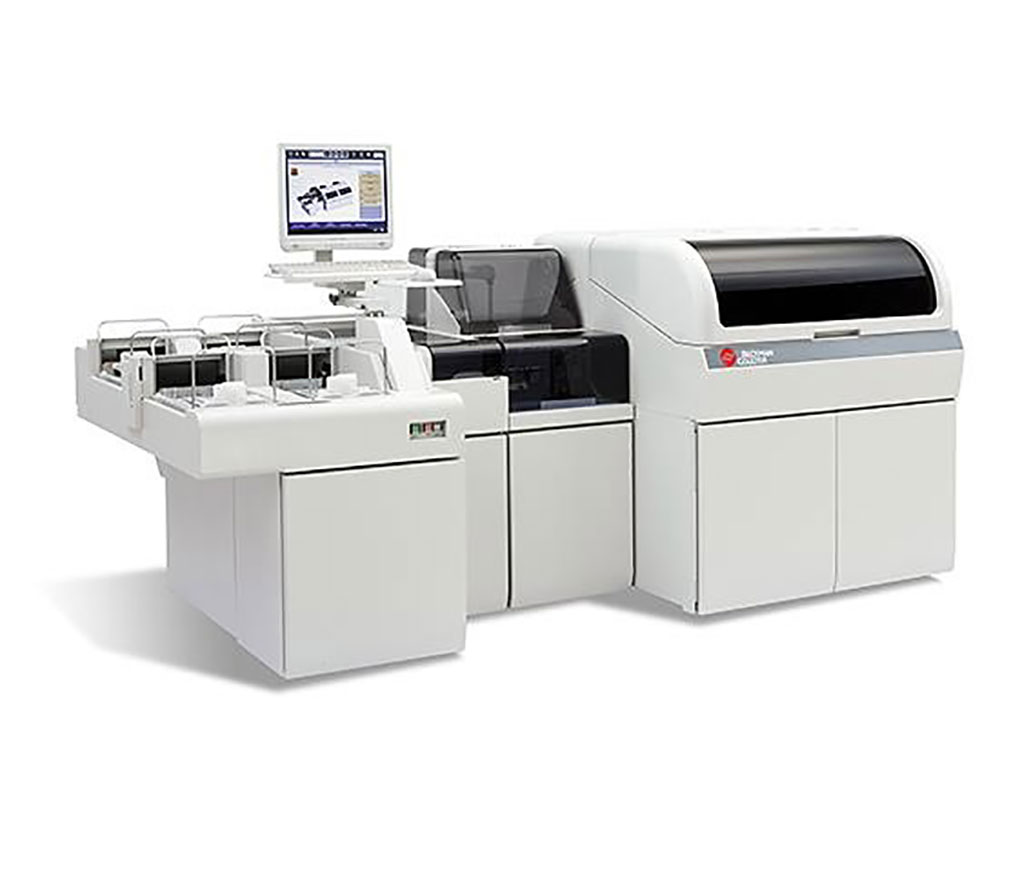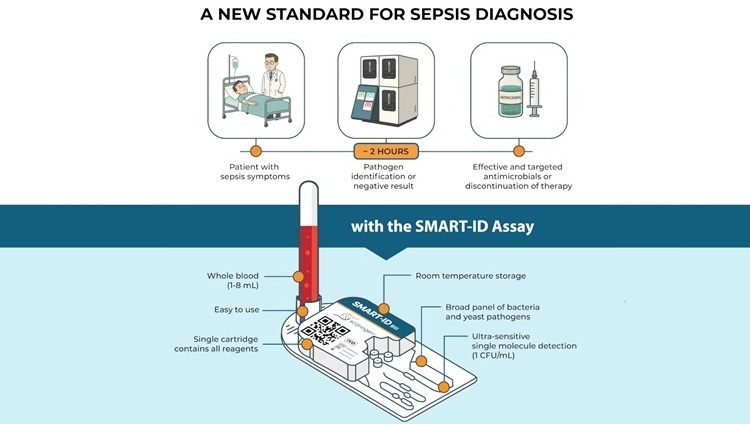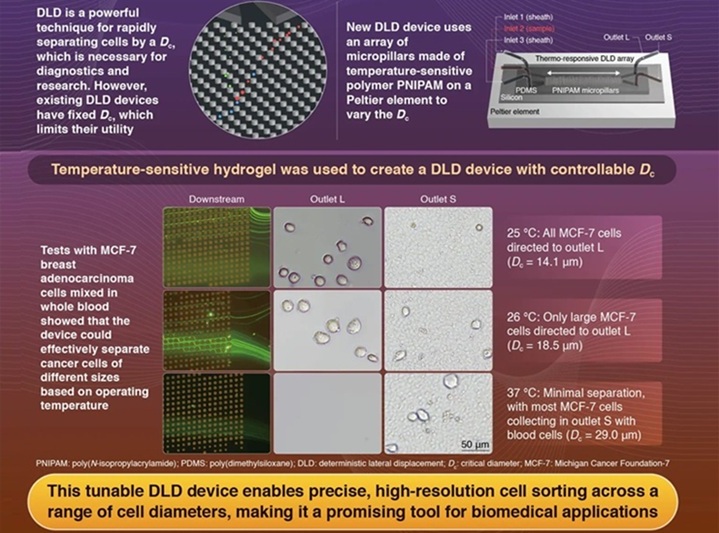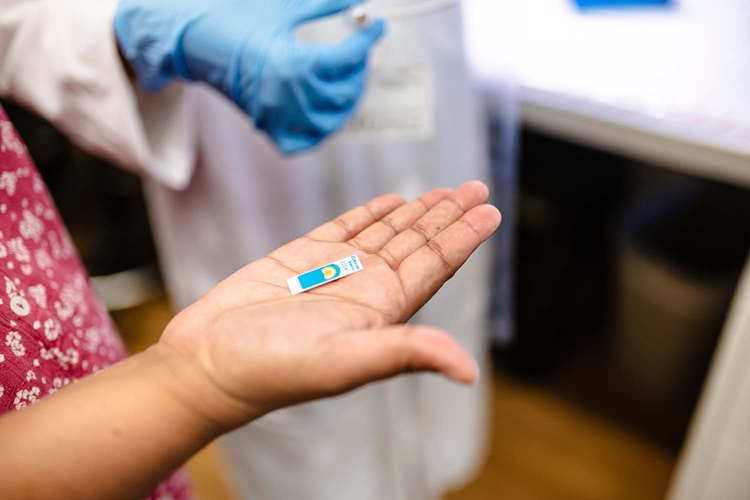Differential Biochemical Markers Identified in Inflammatory Processed Synovial Fluid
|
By LabMedica International staff writers Posted on 28 Jul 2021 |

Image: The AU5800 Clinical Chemistry Analyzer is an automated chemistry analyzer that measures many different chemical analytes (Photo courtesy of Beckman Coulter)
Joint infections with a non-specific presentation are difficult to diagnose, mainly due to the absence of specific clinical signs and symptoms, relative lack of accurate laboratory tests, low virulence due to previous treatment, and biofilm ability of the pathogens.
This difficulty is especially true for patients treated with non-targeted antibiotics, including patients with implanted joint replacements. New biochemical markers are being sought to help quickly determine the extent of the inflammatory process taking place in the joint cavity in routine biochemical practice, either due to its increased concentration in synovial fluid (SF) or directly in serum/plasma.
Clinical Biochemists and their colleagues at the University of Ostrava (Ostrava, Czech Republic) sought to identify biochemical markers in Synovial Fluid (SF) that can predict susceptibility to ongoing inflammatory processes in the joint cavity. Ninety-two consecutive patients were divided into four SF groups based on clustering analysis: non-inflammatory SF (73%), inflammatory-non-pyogenic (12%), inflammatory-pyogenic (10%), or hemorrhagic (5%).
The team measured and compared the levels of the following biochemical markers in SF: glucose, lactate, total protein, uric acid, C-Reactive Protein (CRP), Leukocyte Count (WBC), Mononuclear (MNP), Polymorphonuclear (PMN), Interleukin (IL)-1 beta, IL6, Procalcitonin, Presepsin, Neutrophil Gelatinase-Associated Lipocalin (NGAL), Human Neutrophil Defensin 1-3 (HNP1-3), Cartilage Oligomeric Matrix Protein, Lactoferrin (HLF2), Polymorphonuclear Elastase (PMNE), Matrix Metalloproteinase (MMP)-1, and MMP-3. The concentrations of the biochemical biomarkers were determined on an AU 5800 automated analyzer (Beckman Coulter, Brea, CA, USA). They analyzed hematological parameters, relative and absolute numbers of leukocytes (WBC), and (MNP) and PMN leukocyte counts on a XN-9000 Automated in Body Fluid mode (Sysmex, Kobe, Japan).
The scientists reported that a significant difference between WBC, PMN, MNP, CRP, IL-1β, IL-6, HNP1-3, HLF2, PMNE, and individual groups of SF type. They also found a significant correlation between WBC and PMN, MNP, and CRP; PMN and HNP1-3 and PMNE; IL-6 and PMNE; IL-1β and NGAL, HLF2, and PMNE; HNP1-3 and NGAL, HLF2, and PMNE; NGAL and HLF2 and PMNE; and HLF2 and PMNE concentrations in all SF groups, between WBC and MNP; IL-1β and NGAL and MMP-3; HNP1-3 and PMNE; and NGAL and HLF2 concentrations in the non-inflammatory SF group, and between PMN and MNP in the inflammatory-non-pyogenic and inflammatory-pyogenic SF groups. PMN, MNP, WBC, CRP, and HNP1-3 in SF predicted the inflammatory processes with excellent diagnostic performance.
The authors concluded that SF biomarkers WBC, PMN, MNP CRP, HNP1-3, IL-1, IL-6, PMNE, and HLF2 allow the classification of new patients into the relevant SF group with an accuracy of 94.4%. In addition, WBC, PMN, MNP, CRP, and HNP1-3 provide excellent diagnostic sensitivity and specificity for the diagnosis of infection, despite the study including a limited number of patients with pyogenic and non-pyogenic inflammation. The study was originally published on line on March 15, 2021 in the Journal of Clinical Chemistry and Laboratory Medicine.
Related Links:
University of Ostrava
Beckman Coulter
Sysmex
This difficulty is especially true for patients treated with non-targeted antibiotics, including patients with implanted joint replacements. New biochemical markers are being sought to help quickly determine the extent of the inflammatory process taking place in the joint cavity in routine biochemical practice, either due to its increased concentration in synovial fluid (SF) or directly in serum/plasma.
Clinical Biochemists and their colleagues at the University of Ostrava (Ostrava, Czech Republic) sought to identify biochemical markers in Synovial Fluid (SF) that can predict susceptibility to ongoing inflammatory processes in the joint cavity. Ninety-two consecutive patients were divided into four SF groups based on clustering analysis: non-inflammatory SF (73%), inflammatory-non-pyogenic (12%), inflammatory-pyogenic (10%), or hemorrhagic (5%).
The team measured and compared the levels of the following biochemical markers in SF: glucose, lactate, total protein, uric acid, C-Reactive Protein (CRP), Leukocyte Count (WBC), Mononuclear (MNP), Polymorphonuclear (PMN), Interleukin (IL)-1 beta, IL6, Procalcitonin, Presepsin, Neutrophil Gelatinase-Associated Lipocalin (NGAL), Human Neutrophil Defensin 1-3 (HNP1-3), Cartilage Oligomeric Matrix Protein, Lactoferrin (HLF2), Polymorphonuclear Elastase (PMNE), Matrix Metalloproteinase (MMP)-1, and MMP-3. The concentrations of the biochemical biomarkers were determined on an AU 5800 automated analyzer (Beckman Coulter, Brea, CA, USA). They analyzed hematological parameters, relative and absolute numbers of leukocytes (WBC), and (MNP) and PMN leukocyte counts on a XN-9000 Automated in Body Fluid mode (Sysmex, Kobe, Japan).
The scientists reported that a significant difference between WBC, PMN, MNP, CRP, IL-1β, IL-6, HNP1-3, HLF2, PMNE, and individual groups of SF type. They also found a significant correlation between WBC and PMN, MNP, and CRP; PMN and HNP1-3 and PMNE; IL-6 and PMNE; IL-1β and NGAL, HLF2, and PMNE; HNP1-3 and NGAL, HLF2, and PMNE; NGAL and HLF2 and PMNE; and HLF2 and PMNE concentrations in all SF groups, between WBC and MNP; IL-1β and NGAL and MMP-3; HNP1-3 and PMNE; and NGAL and HLF2 concentrations in the non-inflammatory SF group, and between PMN and MNP in the inflammatory-non-pyogenic and inflammatory-pyogenic SF groups. PMN, MNP, WBC, CRP, and HNP1-3 in SF predicted the inflammatory processes with excellent diagnostic performance.
The authors concluded that SF biomarkers WBC, PMN, MNP CRP, HNP1-3, IL-1, IL-6, PMNE, and HLF2 allow the classification of new patients into the relevant SF group with an accuracy of 94.4%. In addition, WBC, PMN, MNP, CRP, and HNP1-3 provide excellent diagnostic sensitivity and specificity for the diagnosis of infection, despite the study including a limited number of patients with pyogenic and non-pyogenic inflammation. The study was originally published on line on March 15, 2021 in the Journal of Clinical Chemistry and Laboratory Medicine.
Related Links:
University of Ostrava
Beckman Coulter
Sysmex
Latest Immunology News
- New Test Distinguishes Vaccine-Induced False Positives from Active HIV Infection
- Gene Signature Test Predicts Response to Key Breast Cancer Treatment
- Chip Captures Cancer Cells from Blood to Help Select Right Breast Cancer Treatment
- Blood-Based Liquid Biopsy Model Analyzes Immunotherapy Effectiveness
- Signature Genes Predict T-Cell Expansion in Cancer Immunotherapy
- Molecular Microscope Diagnostic System Assesses Lung Transplant Rejection
- Blood Test Tracks Treatment Resistance in High-Grade Serous Ovarian Cancer
- Luminescent Probe Measures Immune Cell Activity in Real Time
- Blood-Based Immune Cell Signatures Could Guide Treatment Decisions for Critically Ill Patients
- Novel Tool Predicts Most Effective Multiple Sclerosis Medication for Patients
- Companion Diagnostic Test for CRC Patients Identifies Eligible Treatment Population
- Novel Tool Uses Deep Learning for Precision Cancer Therapy
- Companion Diagnostic Test Identifies HER2-Ultralow Breast Cancer and Biliary Tract Cancer Patients
- Novel Multiplex Assay Supports Diagnosis of Autoimmune Vasculitis
- Blood Test Predicts Immunotherapy Efficacy in Triple-Negative Breast Cancer
- Simple Genetic Testing Could Predict Treatment Success in Multiple Sclerosis Patients
Channels
Molecular Diagnostics
view channel
Simple Urine Test to Revolutionize Bladder Cancer Diagnosis and Treatment
Bladder cancer is one of the most common and deadly urological cancers and is marked by a high rate of recurrence. Diagnosis and follow-up still rely heavily on invasive cystoscopy or urine cytology, which... Read more
Blood Test to Enable Earlier and Simpler Detection of Liver Fibrosis
Persistent liver damage caused by alcohol misuse or viral infections can trigger liver fibrosis, a condition in which healthy tissue is gradually replaced by collagen fibers. Even after successful treatment... Read moreHematology
view channel
Platelet Activity Blood Test in Middle Age Could Identify Early Alzheimer’s Risk
Early detection of Alzheimer’s disease remains one of the biggest unmet needs in neurology, particularly because the biological changes underlying the disorder begin decades before memory symptoms appear.... Read more
Microvesicles Measurement Could Detect Vascular Injury in Sickle Cell Disease Patients
Assessing disease severity in sickle cell disease (SCD) remains challenging, especially when trying to predict hemolysis, vascular injury, and risk of complications such as vaso-occlusive crises.... Read more
ADLM’s New Coagulation Testing Guidance to Improve Care for Patients on Blood Thinners
Direct oral anticoagulants (DOACs) are one of the most common types of blood thinners. Patients take them to prevent a host of complications that could arise from blood clotting, including stroke, deep... Read moreImmunology
view channel
New Test Distinguishes Vaccine-Induced False Positives from Active HIV Infection
Since HIV was identified in 1983, more than 91 million people have contracted the virus, and over 44 million have died from related causes. Today, nearly 40 million individuals worldwide live with HIV-1,... Read more
Gene Signature Test Predicts Response to Key Breast Cancer Treatment
DK4/6 inhibitors paired with hormone therapy have become a cornerstone treatment for advanced HR+/HER2– breast cancer, slowing tumor growth by blocking key proteins that drive cell division.... Read more
Chip Captures Cancer Cells from Blood to Help Select Right Breast Cancer Treatment
Ductal carcinoma in situ (DCIS) accounts for about a quarter of all breast cancer cases and generally carries a good prognosis. This non-invasive form of the disease may or may not become life-threatening.... Read moreMicrobiology
view channel
Rapid Diagnostic Test Matches Gold Standard for Sepsis Detection
Sepsis kills 11 million people worldwide every year and generates massive healthcare costs. In the USA and Europe alone, sepsis accounts for USD 100 billion in annual hospitalization expenses.... Read moreRapid POC Tuberculosis Test Provides Results Within 15 Minutes
Tuberculosis remains one of the world’s deadliest infectious diseases, and reducing new cases depends on identifying individuals with latent infection before it progresses. Current diagnostic tools often... Read more
Rapid Assay Identifies Bloodstream Infection Pathogens Directly from Patient Samples
Bloodstream infections in sepsis progress quickly and demand rapid, precise diagnosis. Current blood-culture methods often take one to five days to identify the pathogen, leaving clinicians to treat blindly... Read morePathology
view channel
Tunable Cell-Sorting Device Holds Potential for Multiple Biomedical Applications
Isolating rare cancer cells from blood is essential for diagnosing metastasis and guiding treatment decisions, but remains technically challenging. Many existing techniques struggle to balance accuracy,... Read moreAI Tool Outperforms Doctors in Spotting Blood Cell Abnormalities
Diagnosing blood disorders depends on recognizing subtle abnormalities in cell size, shape, and structure, yet this process is slow, subjective, and requires years of expert training. Even specialists... Read moreTechnology
view channel
Artificial Intelligence Model Could Accelerate Rare Disease Diagnosis
Identifying which genetic variants actually cause disease remains one of the biggest challenges in genomic medicine. Each person carries tens of thousands of DNA changes, yet only a few meaningfully alter... Read more
AI Saliva Sensor Enables Early Detection of Head and Neck Cancer
Early detection of head and neck cancer remains difficult because the disease produces few or no symptoms in its earliest stages, and lesions often lie deep within the head or neck, where biopsy or endoscopy... Read moreIndustry
view channel
Abbott Acquires Cancer-Screening Company Exact Sciences
Abbott (Abbott Park, IL, USA) has entered into a definitive agreement to acquire Exact Sciences (Madison, WI, USA), enabling it to enter and lead in fast-growing cancer diagnostics segments.... Read more






















